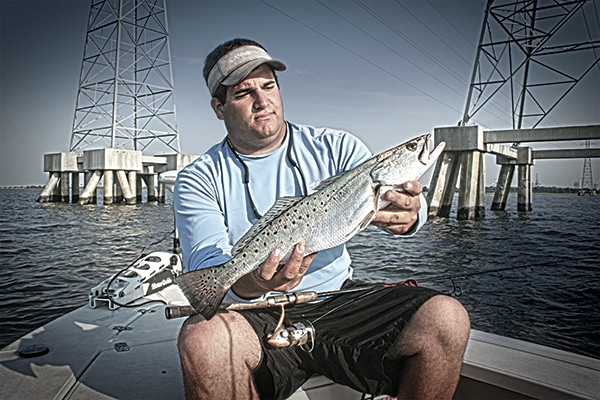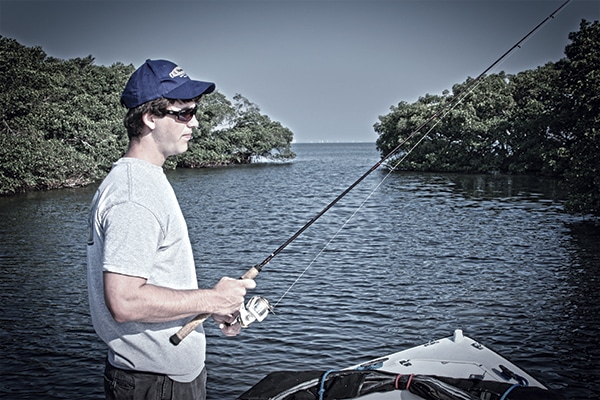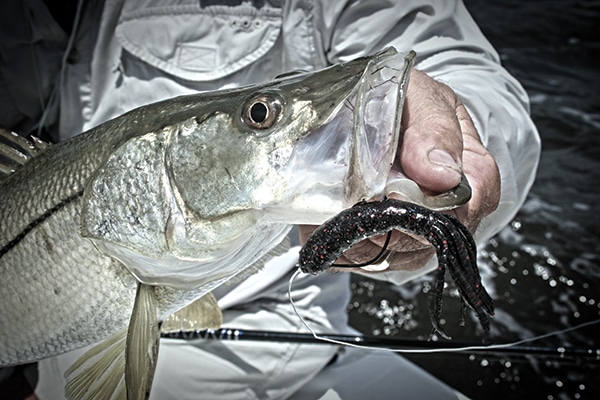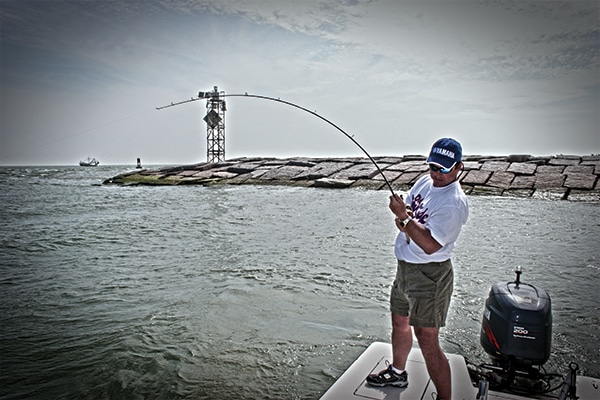
How many times have you tested your favorite fishing spot only to find the action slow? Then seemingly without reason, the place becomes alive with rolling silver backs, or the water turns a sullen gray as pods of fish move into the area. Tide — or current influence on fish and bait — results in such happenings hundreds of times daily throughout the world’s inshore waters. To become a better fisherman, it’s up to you to figure out the best tides for fishing and the best times for fishing in your local areas.

How to Fish Incoming and Outgoing Tides
Veteran inshore anglers know from experience that moving water flips on the feeding switch in virtually all game fish. Falling tides (outgoing tides) or rising ones (incoming tides) produce, depending on location, species of fish, time of year and other factors. But moving water remains the key factor.
In general, fish move to shallow water during flood tides, and follow the water out as tides ebb (fall). This basic concept provides a good starting point for anglers to find fish, especially when learning unfamiliar water. For example, if you decide to fish a back bay off a coastal sound during a strong flood tide, investigate shoreline or flats areas as the fish move into shallower water to forage.
Conversely, when a tide begins to ebb, fish drop back with the flow toward deeper water.

These generalities about tide also hold true for bait: shrimp, crabs, small fish and a host of other marine life. Without much choice, bait gets swept along for the ride in tidal flow, and predatory fish follow in hot pursuit or await their arrival at specific spots. This explains why some inshore locations consistently produce during both incoming and outgoing tides.
For instance, a rising tide pushing hard against a bay mouth point with clear, open-ocean water often brings with it an abundance of baitfish and sport fish. When the tide turns and falls, bait gets pushed back out against the same point, where game fish gorge on food transported by current and pinned against the point. Thus the point has good fishing during flooding and falling tides.
As you might be able to guess, when water is not moving during a slack tide, the bite tends to slow down considerably. Slack tides are not the best time for fishing, in fact, they are often the worst times. Bait is not being flushed into or out of the estuary system, so baitfish and other prey are not in predictable areas. Gamefish often don’t feed during a slack tide because they’re not able to utilize the ambush points available to them during moving tides.
Fishing Tides Around Structure
Inshore structure such as underwater humps or high spots on the bottom attract fish as the tide falls and/or rises for similar reasons, as the point just described offers good fishing. In some cases, game fish alter their location around a hump according to tide direction, choosing one side of a hump during a falling tide, while preferring the opposite side during a rising tide. Such a hump also may yield fish only during incoming tides with clear water, with outgoing dark water not productive. Or its fish-harboring traits could very well be the complete opposite.
Bridge abutments prove another attractive target when fishing incoming and outgoing tides, with fish often concentrating in eddies behind structure and sometimes station themselves in current “seams” between abutments. Downcurrent areas usually yield the best results, but not always. Some species feed at the head of structures with the current pushing hard. Flounder often lie in wait for food on the uptide side of pilings in deep water — they lie flat on the bottom as the current easily slips over them. Whether fishing an incoming or outgoing tide, always retrieve your bait or lure with the current for the most natural presentation.
The Effects of Water Temperature and Tide
Sometimes tidal flow during particular seasons produces banner fishing. John Eggers guides out of Jacksonville Beach, Florida, and prefers cool temperatures during winter to target redfish along the Intracoastal Waterway. Bright sunny days that expose black-mud bottoms during dead low tides offer the key to his fast redfish action. When a tide turns and floods, incoming water is warmed by the mud, which has absorbed heat from bright sunshine.
“The warm flood tide turns on baitfish and crabs, and that brings schools of feeding redfish, and we tear them up,” he said. “If it’s overcast with no sunshine, the mud doesn’t heat up, and the flood tide washing over the exposed areas doesn’t wake up the bait, so reds don’t show. This tide-flow setup is only a cool-weather pattern, and is completely dependent on sunlight heating exposed black-mud bars at low water.”

How To Find Fish on Incoming and Outgoing Tides
Running tides pushing through bottlenecks make classic ambush spots for predators. Creeks connecting bays, sounds, rivers, and backwaters potentially yield fast action when tide and current run strong. Sometimes culvert areas under roadways and bridges in tidewater zones generate good fishing during a hard tide push. Birds often tip off the whereabouts of bait which, in turn, reveals the likely presence of predatory fish.
“Mangrove cuts are some of my favorite and most productive snook spots,” says Tampa Bay guide Capt. Joel Brandenburg of Apollo Beach, Florida. “Some of the best places are small bottlenecks between two big backwaters because they’ll have good fishing during any moving-tide phase. Flooding or ebbing water pushes bait back and forth through bottlenecks, and that turns snook on in the narrow confines of a cut.”
Top angler Jake Markris of Fairhope, Alabama, located a broad flat that dropped off from 3 to 8 feet, a hot spot for Mobile Bay seatrout and redfish during falling tides. Current pushed against the drop-off ledge of the flat, pinning bait and drawing feeding reds and trout.
Markris tested the spot during rising tides but couldn’t buy a trout or redfish on plugs and spoons. Then one day while waiting for the tide to turn, he probed the deep ledge side of the flat slowly with jigs and live mullet, and instantly started catching flounder during an incoming tide. Bottom-hugging flounder stacked along the deep side of the ledge waiting for bait to be swept across the flat and into the deeper water with a flooding tide.
Markris never discovered flatfish while working plugs and spoons for trout and redfish high in the water column. He had to change tactics and the depth of water that he worked to catch flounder during an incoming tide.

Fishing During the Slack Tide
Slack or “dead” water rarely produces inshore, at least compared with places of strong tide-flow areas. But exceptions exist, especially in regions where big tides rarely flow. In the Gulf of Mexico, for example, high- and low-tide differentials are minimal, at least compared with Eastern Seaboard and Pacific Coast tides. So a slow tidal push that wouldn’t excite a Chesapeake Bay angler likely would bring smiles to a Louisiana tide marsh hound.
In slow-running tidal areas such as the Gulf of Mexico, days with only one high and one low tide per day still allow for banner fishing opportunities. River current, for example, often creates productive spots. Current produced by strong wind also can make for good fishing because it might push and concentrate bait.

Move Fishing Spots to Find the Best Tides
In coastal areas with good tide differentials, anglers have the option of “chasing” tides. In other words, areas such as these allow anglers to run to various locations to stay with optimal tidal movement for good fishing all day. Some coastal river systems have good running tides that suddenly slow, but the same conditions can be found again by simply running a boat a mile or two up-river or down-river to where current is still flowing well. In broad waters, sometimes just a move across a river or bay can be enough to locate good tide flow, resulting in hot fishing.
Yet too much of a good thing hinders anglers at times. Extra-strong tides during new- or full-moon phases make fishing difficult. Species like bluefish, ladyfish, mackerel and big redfish might feed well during strong tides inshore. But other species turn off when fighting strong flow, or they move deep, which makes pinpointing their location difficult, and makes effectively presenting lures and baits more challenging.
Perhaps the most important part of reading tides inshore is knowing that fish neither feed nor choose their location haphazardly. Take note of where you catch fish, the tide phase and the time of year. Soon timing tides and reading them starts to make sense, and your catch rate will soar, helping you figure out the best times to fish in your home waters.









